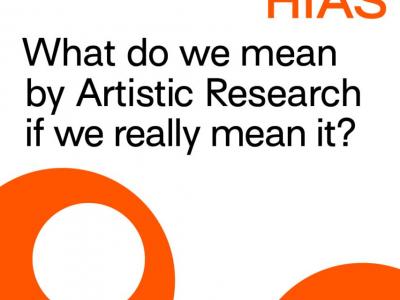
A guest blog by Postdoctoral Fellow Dr Alex South:
What do we mean by Artistic Research if we really mean it?
This was the motivating question behind a NetIAS debate organized by and staged in the Hamburg Institute for Advanced Studies (HIAS) on 5 June 2025. The debate gave a public airing to a week-long private discussion held within a multidisciplinary group of NetIAS researchers of which I was privileged to be a member, alongside Wulan Dirgantoro (HIAS), Clemens Krauss (ZiF, Bielefeld), Massimo Leone (HIAS), Rania Stephan (Iméra, Aix-Marseille), and Jason Waite (Helsinki Collegium for Advanced Studies). Our artistic practices included curation, filmmaking, music, and painting; our academic and other disciplines encompassed art history, bioacoustics, cultural studies, ecomusicology, philosophy, psychoanalysis, and semiotics. This breadth reflects the scope of HIAS, which offers fellowships across the full range of academic disciplines (wissenschaften) as well as taking artists in residence. The fact that HIAS includes the natural and social sciences alongside the arts and humanities perhaps explains why I was there for IASH: my own disciplinary background is broad, spanning the physical and life sciences, philosophy, musicology, and music performance.
During the days in HIAS we presented to each other on our artistic practices and research, and also participated in several informal and interactive sessions. HIAS supported us with space, time, and refreshments, and our hosts Ulrike Dorfmüller and Lola Mense occasionally made decisive contributions to our discussions (alongside HIAS secretary-general Christian Suhm when he was with able to be with us). The presence of students from Hamburg HE institutions facilitated minute-taking and the live-streaming of the debate. HIAS had also coordinated with a partner institution, the Hochschule für Musik und Theater Hamburg (HfMT), and we spent an enjoyable morning touring its facilities and discussing questions of artistic (musical) research with Georg Hajdu and Greg Beller. As a clarinettist, I was particularly interested to learn that Georg had collaborated with clarinet-maker Stephen Fox on the construction of instruments designed to perform in the unusual Bohlen-Pierce scale. Naturally, our debates frequently continued within the smaller groups formed as we roamed the local area, strolled with the geese along the banks of the Aussenalster (a large lake in the centre of Hamburg), and visited the Bas Jan Ader exhibition at the Hamburger Kunsthalle.
To return to the topic of our meeting: early on we noted that although the meaning of Artistic Research is highly significant, for some of us it had not been the target of extensive and/or explicit reflection. More than this, some of our artistic practitioners wondered whether trying to unite artistic practice with research might not be detrimental to the quality of the art, for example through excessive theorizing before production. Here I remembered the composer Piers Hellawell’s (2014) provocative piece ‘Treating Composers as Researchers is Bonkers’, and the debate that followed in the pages of the music journal Tempo (e.g., Croft, 2015; Pace, 2016). I also found it useful to recall the often-proposed three-way distinction between research on, for, and in (or through) art and its creative practices (e.g., Borgdorff, 2011). Some of us had carried out research on specific works of art, analysing and interpreting from our own disciplinary perspectives. And in our presentations, the practitioners amongst us had described the research we had done in the service of artistic practice: site visits, work in archives, experimentation with materials and techniques. Yet it is the third aspect of artistic research that remains the most challenging to articulate, in part because it is precisely the nature of most art works to provide us with non-verbal aesthetic experiences that resist articulation, and subsequent attempts at ‘effing the ineffable’ (as has Roger Scruton put it in another context) do not always go well.
For myself, the conversations we had at HIAS led to some new reflections regarding artistic research (in and through art). To begin with, these discussions showed clearly how an artist’s identification of their own research inquiry, as recommended by Bulley and Şahin (2021), could be aided by external perspectives (whether of other artists or of academic researchers). This was substantiated by the transversal themes that emerged somewhat unexpectedly during the sharing of our work: questions of empathy, multispecies relationships, memory, and vulnerability. Further, that in artistic research – typically driven by the desire or need to experiment with artistic forms and aesthetic experience rather than by ‘research questions’ or hypotheses (Borgdorff, 2011) – theoretical frameworks might be most useful only after the start of research. And finally, that any particular artist has their own methodology, which must be part of why it has been difficult to pin down just what we mean by artistic research. Our conversations at HIAS also left us with new questions: What are the findings of artistic research? How do they enter into the circulation of academic discourse? In conclusion: a rich and productive week that opened new avenues of thought and feeling, that for me at least are likely to shape my own artistic practice as well as its framing as research.
References
Borgdorff, H., 2011. ‘The Production of Knowledge in Artistic Research’, in The Routledge Companion to Research in the Arts. Routledge, pp.44–63.
Bulley, J. and Sahin, O., 2021. Practice Research - Report 1: What is practice research? and Report 2: How can practice research be shared? London: Practice Research Advisory Group UK. https://doi.org/10.23636/1347.
Croft, J., 2015. Composition is Not Research, Tempo, 69(272), pp.6–11. https://doi.org/10.1017/S0040298214000989.
Hellawell, P., 2014. Treating Composers as Researchers is Bonkers, Standpoint. Available at: https://standpointmag.co.uk/issues/may-2014/critique-may-14-treating-com... (Accessed: 30 May 2019).
Pace, I., 2016. Composition and performance can be, and often have been, research, Tempo, 70(275), pp.60–70. https://doi.org/10.1017/S0040298215000637.
